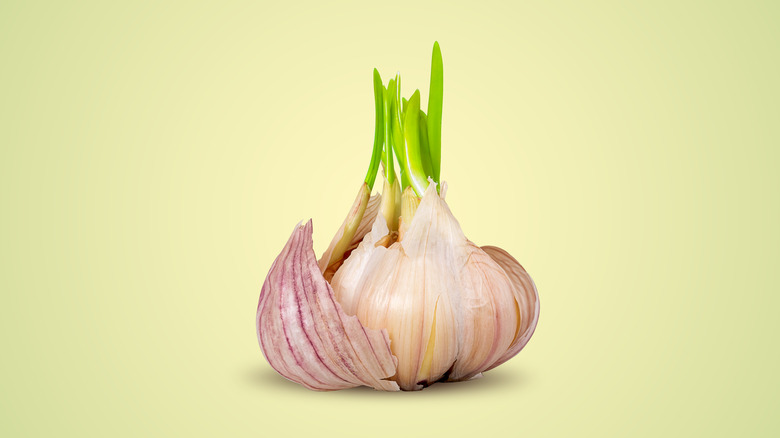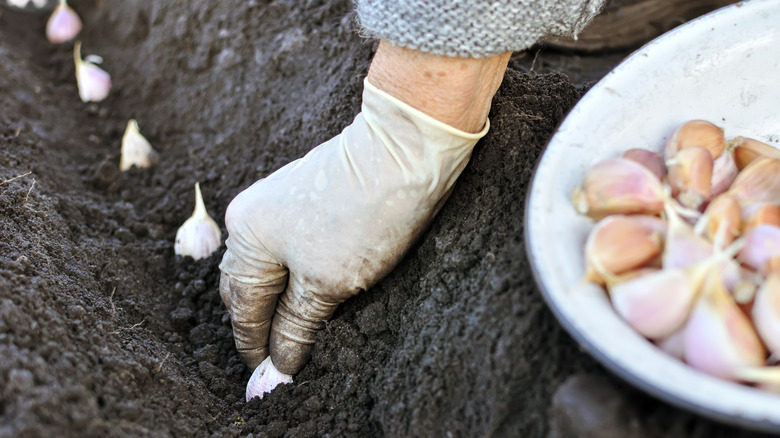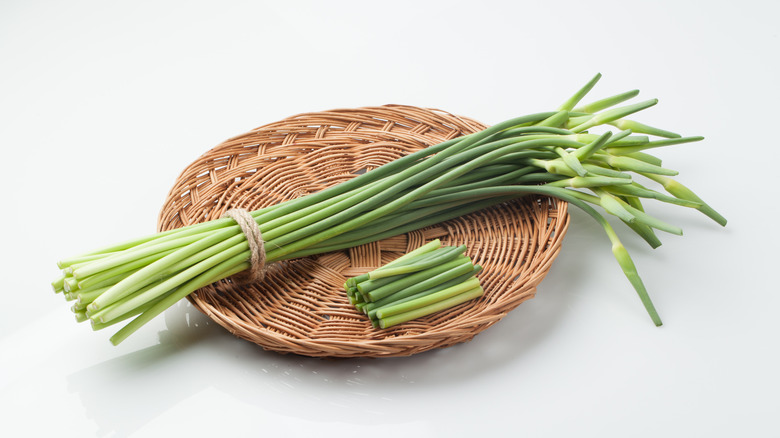Why Sprouted Garlic Tastes So Different
Garlic is an indispensable ingredient in any kitchen. It's delicious, nutritious, and extremely versatile. Chances are high that you have a head or two of garlic in your kitchen right now, but if it's been there for a while, you might notice a clump of green stalks sprouting from the center of each clove. There's nothing dangerous about these protrusions (unlike sprouted potatoes), in fact, the levels of antioxidants in garlic increase as it sprouts. From a cooking standpoint, however, sprouted garlic can pose an issue, as it takes on a bitter flavor.
It's a misconception that the sprouts themselves are bitter. They only taste mildly grassy. In reality, the sprouting process triggers a chemical change that reduces the garlic's natural sugar level and makes the clove itself bitter. People often think that they're supposed to remove the sprouts from garlic cloves before cooking with them, but that won't make any difference (other than adding tedious work to your recipe). That being said, sprouted garlic isn't a lost cause. There's a lot you can do with it.
What to do with sprouted garlic
Generally speaking, you can cook with sprouted garlic cloves in the same way you would cook with un-sprouted cloves. However, there are certain recipes for which you will have to account for the change in flavor. In dishes that only call for a clove or two, you probably won't be able to taste any difference, but if you're making something where garlic is a primary flavor, such as homemade aioli, you really should use un-sprouted cloves to avoid overpowering bitterness.
You won't have to deal with sprouted garlic cloves as much if you store your garlic properly. It's best to store garlic bulbs whole, as they spoil faster when the cloves are separated. Choose a cool, dry storage space, away from any sunlight. However, you don't want to put garlic in the refrigerator, as garlic sprouts faster in cold environments. The ideal temperature for storing garlic is between 60 and 65 degrees Fahrenheit.
There's another use for sprouted garlic cloves — growing your garlic. To do so, bury the sprouted cloves (unpeeled) in soil, about 4 inches deep, and with at least 2 inches of space between each clove. If you live in a cold region, you can plant them outside during fall, and they will be ready to harvest in spring. Alternatively, you can grow garlic in a pot indoors, keeping it cool and watering it every two or three days.
Sprouted garlic vs green garlic vs. garlic scapes
It's easy to get confused between sprouted garlic, green garlic, and garlic scapes — all three are garlic bulbs with green stalks growing out of them — but each one is unique. Green garlic is simply garlic that was harvested before it fully matured, so the bulb hasn't split into individual cloves yet. It's also known as spring or baby garlic. It tastes milder and sweeter than the fully grown plant. Green garlic also has slight notes of scallion, which it closely resembles.
Garlic scapes are the shoots that emerge from the soil as the garlic plant reaches maturity. At first, they look just like the sprouts that pop out of garlic cloves, but they keep growing to the point that they resemble extra-long chives. If left in the ground long enough, the scapes will become curly and sprout tiny flowers at their tips. The biggest difference between garlic scapes and the sprouted garlic in your kitchen is that scapes only grow from hardneck garlic plants, and the vast majority of garlic sold in grocery stores is of the softneck variety.
The sprouts that grow from garlic cloves are an entirely different matter. They are the beginnings of new garlic plants, which is why you can use them to grow your garlic. Unlike green garlic and garlic scapes, which both have a subtle garlic flavor, garlic sprouts only have a slight grassy taste and don't serve a cooking purpose in their own right.


